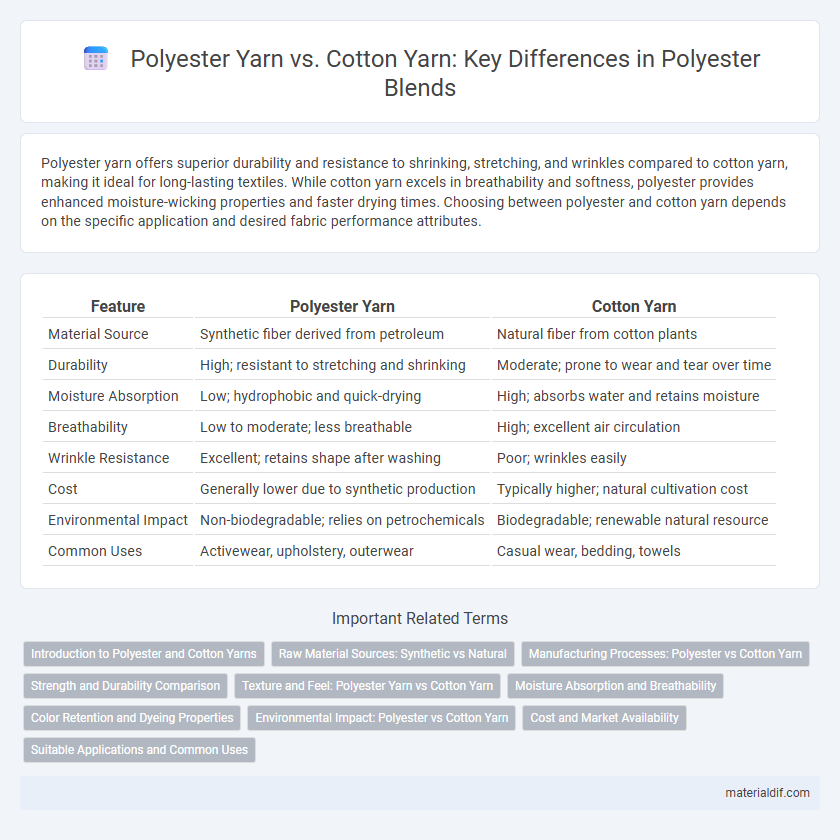Polyester yarn offers superior durability and resistance to shrinking, stretching, and wrinkles compared to cotton yarn, making it ideal for long-lasting textiles. While cotton yarn excels in breathability and softness, polyester provides enhanced moisture-wicking properties and faster drying times. Choosing between polyester and cotton yarn depends on the specific application and desired fabric performance attributes.
Table of Comparison
| Feature | Polyester Yarn | Cotton Yarn |
|---|---|---|
| Material Source | Synthetic fiber derived from petroleum | Natural fiber from cotton plants |
| Durability | High; resistant to stretching and shrinking | Moderate; prone to wear and tear over time |
| Moisture Absorption | Low; hydrophobic and quick-drying | High; absorbs water and retains moisture |
| Breathability | Low to moderate; less breathable | High; excellent air circulation |
| Wrinkle Resistance | Excellent; retains shape after washing | Poor; wrinkles easily |
| Cost | Generally lower due to synthetic production | Typically higher; natural cultivation cost |
| Environmental Impact | Non-biodegradable; relies on petrochemicals | Biodegradable; renewable natural resource |
| Common Uses | Activewear, upholstery, outerwear | Casual wear, bedding, towels |
Introduction to Polyester and Cotton Yarns
Polyester yarn, a synthetic fiber derived from petroleum-based products, offers high durability, wrinkle resistance, and moisture-wicking properties, making it popular in activewear and industrial textiles. Cotton yarn, a natural fiber harvested from cotton plants, is prized for its breathability, softness, and hypoallergenic qualities, widely used in casual and luxury fabrics. Understanding the distinct characteristics of polyester and cotton yarns informs choices in textile manufacturing based on desired fabric performance and comfort.
Raw Material Sources: Synthetic vs Natural
Polyester yarn is produced from synthetic polymers derived mainly from petrochemicals, providing consistent quality and high durability. In contrast, cotton yarn originates from the natural fibers of the cotton plant, offering breathability and biodegradability but with variations influenced by agricultural conditions. The synthetic nature of polyester supports mass production and moisture resistance, whereas cotton's natural sources contribute to its softness and environmental renewability.
Manufacturing Processes: Polyester vs Cotton Yarn
Polyester yarn manufacturing involves polymerization, melt spinning, and drawing, producing synthetic fibers with consistent strength and moisture resistance. Cotton yarn is made through harvesting, ginning, carding, combing, and spinning natural cotton fibers, emphasizing softness and breathability. The synthetic process allows mass production with controlled properties, while cotton manufacturing relies on agricultural quality and manual labor.
Strength and Durability Comparison
Polyester yarn exhibits significantly higher tensile strength and durability compared to cotton yarn, making it more resistant to wear and tear over time. Its synthetic fibers maintain structural integrity under stress and exposure to environmental factors such as moisture and UV light, whereas cotton tends to weaken and degrade faster. Consequently, polyester yarn is preferred in applications requiring long-lasting fabric performance and enhanced strength.
Texture and Feel: Polyester Yarn vs Cotton Yarn
Polyester yarn features a smooth, slightly stiff texture that resists wrinkles and retains shape, making it ideal for activewear and durable fabrics. Cotton yarn offers a soft, breathable, and natural feel, prized for comfort and moisture absorption in everyday clothing. The contrasting textures influence fabric performance, with polyester providing durability and cotton excelling in softness and breathability.
Moisture Absorption and Breathability
Polyester yarn exhibits low moisture absorption, typically absorbing less than 1% of its weight in water, which leads to quicker drying but reduced breathability compared to cotton yarn that can absorb up to 27% of its weight. Cotton yarn allows superior airflow and natural ventilation, enhancing comfort in warm or humid conditions, while polyester's dense fibers often trap heat and moisture next to the skin. This difference makes polyester less suitable for garments requiring high moisture wicking and breathability, favoring cotton in applications demanding comfort and moisture management.
Color Retention and Dyeing Properties
Polyester yarn exhibits superior color retention due to its synthetic fibers, which resist fading and maintain vibrant hues over time, unlike cotton yarn prone to color loss. The dyeing properties of polyester require disperse dyes applied at high temperatures, allowing deep penetration and durability, while cotton accepts direct or reactive dyes with easier processing but limited wash fastness. Consequently, polyester yarn is preferred for applications demanding long-lasting color intensity and resistance to washing and sunlight exposure.
Environmental Impact: Polyester vs Cotton Yarn
Polyester yarn, derived from petroleum-based synthetic fibers, has a higher carbon footprint and contributes significantly to microplastic pollution in oceans compared to cotton yarn, which is biodegradable and renewable. Cotton cultivation demands extensive water, pesticide, and land use, potentially leading to soil degradation and water scarcity issues. Sustainable practices like organic cotton farming and recycled polyester production aim to reduce environmental impacts of both yarn types.
Cost and Market Availability
Polyester yarn is significantly more cost-effective than cotton yarn due to lower production expenses and synthetic fiber durability. The global market offers broader availability of polyester yarn, driven by higher demand in textile and apparel industries for its moisture resistance and strength. While cotton yarn remains preferred for comfort and breathability, polyester yarn dominates in affordable, mass-produced fabric markets.
Suitable Applications and Common Uses
Polyester yarn offers high durability, moisture resistance, and quick drying properties, making it ideal for activewear, outdoor gear, and upholstery. Cotton yarn, known for its breathability, softness, and natural comfort, is commonly used in everyday clothing, bed linens, and casual wear. Both fibers serve unique applications based on performance needs, with polyester favored in technical textiles and cotton preferred for comfort-centric products.
Polyester Yarn vs Cotton Yarn Infographic

 materialdif.com
materialdif.com